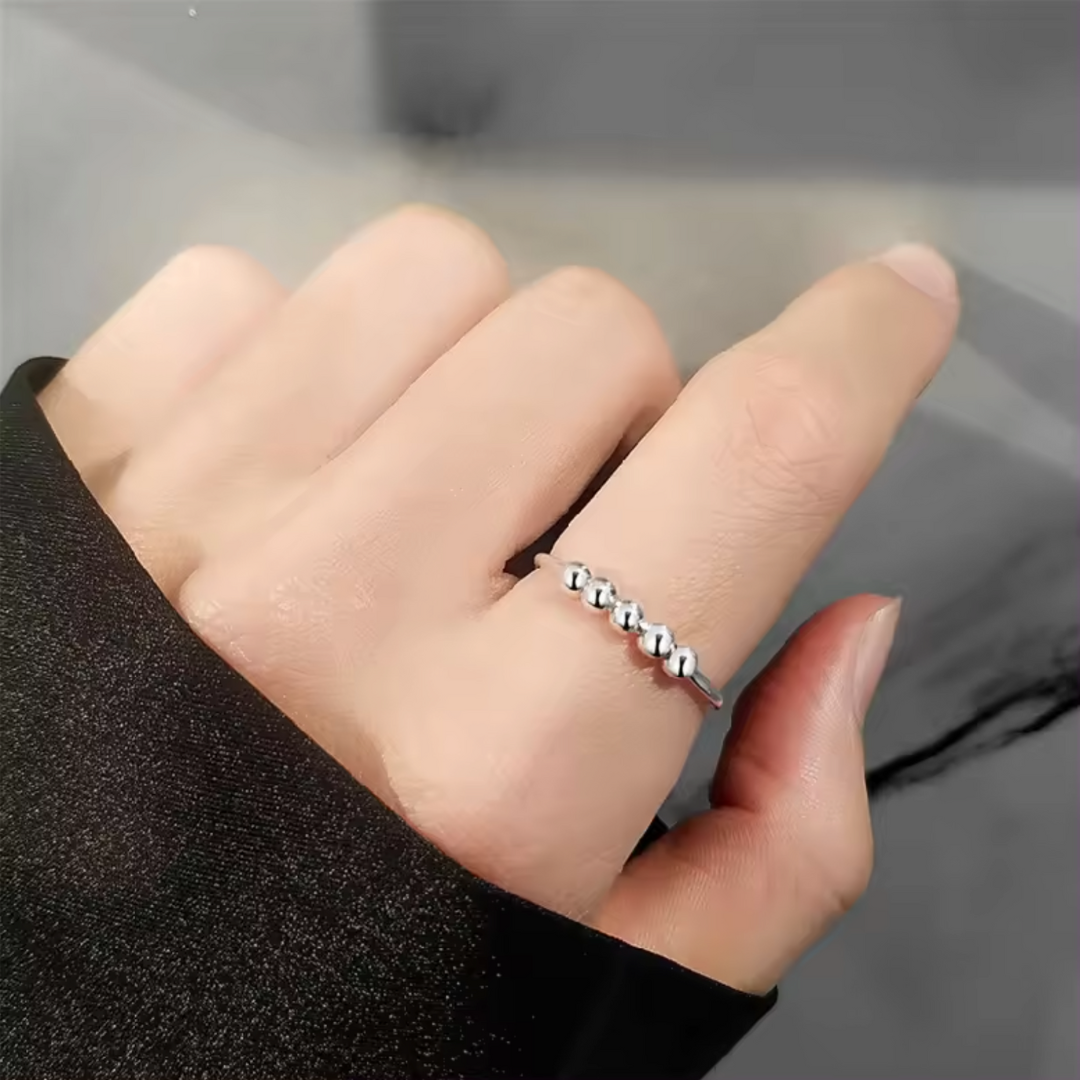An anxiety ring is more than just a piece of jewelry—it’s a simple yet effective tool designed to help manage stress and restlessness. Often referred to as a spinner ring or fidget ring, this accessory typically features a rotating outer band that moves around a fixed inner band. The movement provides a soothing, repetitive action that can help calm nerves, reduce fidgeting, and refocus the mind when anxiety starts to creep in.
People who struggle with anxious thoughts or habits like nail-biting and skin-picking often find an anxiety ring to be a great alternative. It offers a discreet, stylish, and functional way to channel restless energy into something productive. Whether you’re in a stressful meeting, waiting in line, or dealing with overthinking, the simple motion of spinning the ring can create a sense of calm and control.
How Does an Anxiety Ring Work?
The concept behind an anxiety ring is rooted in mindfulness and sensory grounding techniques. When anxiety hits, it’s easy for thoughts to spiral out of control. Spinning or moving the outer band of the ring gives your hands something to do, helping redirect your focus away from stressful thoughts and back to the present moment. The tactile sensation can serve as a gentle reminder to breathe, slow down, and ground yourself.
For many people, this small act of physical engagement helps ease anxiety symptoms because it triggers a sense of rhythm and repetition. These motions are known to activate parts of the brain associated with relaxation and calm. In a way, an anxiety ring provides a mini form of meditation, but one that you can carry around anywhere.
Benefits of Wearing an Anxiety Ring
The benefits of wearing an anxiety ring go far beyond just looking stylish. One of the biggest advantages is its ability to reduce tension in the body. When you feel anxious, your body tends to tighten up—especially in your hands. Spinning or fidgeting with a ring gives your muscles a release and your mind a distraction, helping to prevent stress from building up.
Another benefit is improved focus and mindfulness. Many people use their anxiety ring during moments of deep thought or while working on complex tasks. The repetitive motion can help keep the brain engaged while reducing distractions. It’s a subtle form of self-soothing that doesn’t draw attention but provides noticeable results.
Different Types of Anxiety Rings
There are several styles of anxiety rings, and each offers its own unique features. The most common is the spinner ring, which has a rotating outer band that moves freely. This type is perfect for people who enjoy a smooth, circular motion that’s both quiet and calming. Some designs use small beads or movable components instead of a single band, allowing for different textures and sensations when touched.
You can also find anxiety rings made from various materials like sterling silver, stainless steel, gold, or silicone. The material you choose depends on your lifestyle and personal preference. For example, metal rings tend to be more durable and elegant, while silicone ones are great for people with active routines or metal allergies. No matter the style, the key is comfort—your ring should feel natural and effortless on your finger.
Why People Are Turning to Anxiety Rings Instead of Fidget Toys
While fidget toys and stress balls are popular, the anxiety ring offers a more discreet and sophisticated alternative. You can wear it anywhere—whether at work, a social event, or even during a formal meeting—without feeling self-conscious. It looks like a regular ring, but it doubles as a personal tool for emotional regulation.
Another reason people prefer anxiety rings is their convenience. Unlike larger fidget tools that you have to carry separately, an anxiety ring is always on your finger. This makes it instantly accessible whenever you need it. You don’t have to dig through your bag or worry about losing it, making it a practical choice for managing anxiety throughout the day.
How to Choose the Perfect Anxiety Ring for You
Selecting the right anxiety ring involves more than just picking a pretty design. Start by considering how you plan to use it. If you tend to fidget a lot, look for a ring with a smooth spinner that moves easily without much effort. If you prefer tactile stimulation, you might enjoy one with textured details or multiple moving beads.
Size is also crucial. A ring that’s too tight will feel uncomfortable and may limit movement, while one that’s too loose could fall off easily. It’s best to measure your finger accurately before purchasing. Additionally, think about the material—if you have sensitive skin, hypoallergenic options like stainless steel or silver are ideal. The right ring should feel natural and relaxing to wear all day long.
The Psychology Behind Anxiety Rings
From a psychological perspective, an anxiety ring works because it creates a sensory distraction. Anxiety often feeds on excess mental energy and tension. By providing a physical outlet, the ring interrupts that cycle. It allows your body and mind to collaborate in calming down rather than fueling worry or panic.
Psychologists have long recognized the value of repetitive movements in reducing stress. Similar to tapping your fingers or doodling, spinning the ring engages your senses and brings you back to the present. This technique, known as grounding, helps prevent overthinking by focusing your attention on something tangible and controllable.
When and How to Use an Anxiety Ring Effectively
You can use an anxiety ring anytime you feel uneasy or distracted. For example, before an important presentation, take a moment to breathe deeply and gently spin the ring to center yourself. During long commutes or stressful conversations, it can help you stay composed and focused without showing visible signs of nervousness.
It’s also beneficial to use the ring as part of a mindfulness routine. Combine it with breathing exercises or meditation to enhance relaxation. The goal isn’t to rely entirely on the ring, but to use it as a helpful tool to build calmness and awareness throughout the day.
Anxiety Rings as a Fashion Statement

Aside from their functional benefits, anxiety rings have become a stylish addition to everyday fashion. Many jewelry designers now craft them in elegant and modern styles that look just as beautiful as traditional rings. You’ll find options with engraved patterns, gemstones, or minimalist finishes that suit different personalities and occasions.
Wearing one can be a form of self-expression. It allows you to embrace both fashion and wellness in one piece. Whether you prefer a subtle silver band or a bold, intricate design, your anxiety ring can reflect your taste while supporting your emotional well-being.
Caring for Your Anxiety Ring
To keep your anxiety ring in top shape, regular maintenance is key. Since the ring involves moving parts, dust and moisture can sometimes affect its smoothness. Wipe it gently with a soft cloth and avoid exposing it to harsh chemicals like perfumes or cleaning products.
If your ring is made of metal, occasional polishing can help maintain its shine. For silicone or beaded styles, warm soapy water is usually enough for cleaning. Proper care not only preserves its appearance but also ensures it continues to function effectively for stress relief.
The Science of Touch and Calmness
The reason an anxiety ring works so well lies in the science of touch. Human touch and tactile feedback play a crucial role in emotional regulation. When you spin or move the ring, your brain receives sensory input that signals safety and comfort, helping reduce the body’s fight-or-flight response.
This tactile stimulation is similar to how some people use weighted blankets or stress balls. The rhythmic movement provides comfort through predictability. It’s a natural, non-invasive way to help the body relax and regain balance during stressful moments.
Can Anxiety Rings Really Help with Anxiety?
While an anxiety ring isn’t a cure for anxiety disorders, it can definitely help manage symptoms. Think of it as a supportive companion—something that reminds you to stay calm and grounded. Many users report feeling more in control of their thoughts and emotions after using one consistently.
However, it’s important to remember that anxiety management often requires a combination of techniques. Mindfulness practices, therapy, exercise, and healthy routines all play a part. The ring works best when used as part of a holistic approach to self-care and emotional wellness.
Common Myths About Anxiety Rings
A common misconception about anxiety rings is that they’re only for people with severe anxiety. In reality, anyone who experiences occasional stress, restlessness, or nervous habits can benefit from using one. They’re designed for everyday life and can be a great addition to anyone’s mental health toolkit.
Another myth is that these rings are just a trend. While they have gained popularity in recent years, the concept of using physical movement to reduce anxiety has existed for centuries. The modern anxiety ring is simply a stylish evolution of an age-old calming technique.
Conclusion
An anxiety ring is a small but powerful tool that combines style, mindfulness, and comfort. Whether you’re dealing with daily stress, occasional worry, or simply want a way to stay focused, this ring can make a meaningful difference. Its simple design hides a deep purpose—to help you find calmness in motion.




